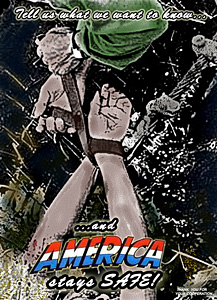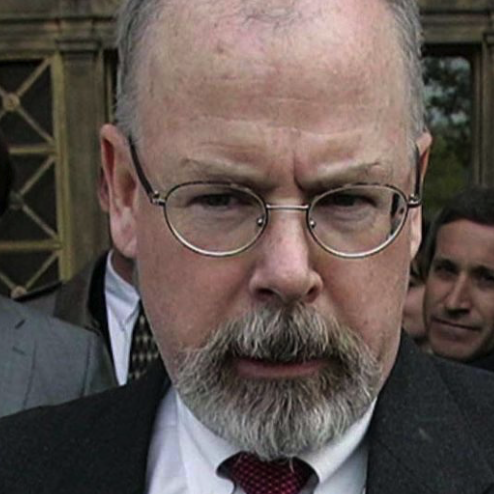Update: Meanwhile, the Spanish judge threw out the case.
A SPANISH judge overnight dismissed a complaint filed against former top US officials over alleged torture at the Guantanamo Bay detention camp. Judge Eloy Velasco decided to throw out the case as he said the US justice system is competent to handle any such complaint.
The last time Spain considered investigating American torture, DOJ and Spain’s Chief Prosecutor Jose Zaragoza worked together to find a way for Spain to decline the case: shortly after Zaragoza told us that “if a proceeding regarding this matter were underway in the U.S., that would effectively bar proceedings in Spain,” Eric Holder asked John Durham to investigate torture. There’s no visible sign in the least, mind you, that Durham has investigated the crimes in his mandate (which includes, among other things, the use of death threats against Abd al Rahim al-Nashiri and the manslaughter of Gul Rahman in Afghan’s Salt Pit). But his investigation serves as a convenient diplomatic stunt to shield American torture from Spanish law.
DOJ attempts to stave off Spanish investigations by claiming we investigate torture
DOJ’s back in the diplomatic stunt business with a letter attempting to convince Spain to drop its investigations of the lawyers who authorized torture.
We understand from Judge Velasco’s request that a criminal complaint has been made by the Association for the Dignity of Spanish Prisoners, claiming that the United States, as part of a strategy in its conflict with the Taliban and Al Qaeda and its affiliates, sanctioned a series of executive orders supported by legal memoranda drawn up by the above-listed persons and their legal counsel and advisors, authorizing interrogation techniques in violation of international conventions in force. We have also been advised that the complaint further alleges that U.S. government personnel used the memoranda as a legal basis to conduct interrogations using these illegal techniques upon persons suspected of acting in concert with Al Qaeda and the Taliban. In the request, Judge Velasco seeks information indicating whether any U.S. authority has instituted investigations or proceedings in connection with the facts describes in the above-referenced complaint, and, if so, the specific authority (administrative or judicial) that has dealt or is dealing with such matters. The request further notes that if the facts are currently being investigated by U.S. authorities, that the referenced complaint will be sent to the United States in order that the facts reported therein may be investigated by the United States.
There’s a lot that is misleading about DOJ’s response letter. But one of its key strategies is badly fraudulent: the centrality of its focus on David Passaro’s conviction for assault. The letter boasts:
In 2003 [EW: it was 2004], the U.S. Department of Justice brought criminal charges against Passaro, a CIA contractor accused of brutally assaulting a detainee in Afghanistan in 2003. The CIA described his conduct as “unlawful, reprehensible, and neither authorized nor condoned by the Agency.” The then Attorney General stated that “the United States will not tolerate criminal acts of brutality and violence against detainees….” And the U.S. Attorney noted that the extraterritorial jurisdiction exercised by the United States is “[n]ot only vital to investigating and prosecuting terrorists, but also it is instrumental in protecting the civil liberties of those on U.S. military installations and diplomatic missions overseas, regardless of their nationality.” See press release at http://www.justice.gov/opa/pr2004/June/04_crm_414.htm, a copy of which is annexed as Attachment A hereto. Following a jury trial, Passaro was convicted of felony assault. On August 10, 2009, the United States Court of Appeals for the Fourth Circuit upheld the conviction, holding that a U.S. federal court has jurisdiction over the trial of an American citizen for committing assaults on the premised of U.S. military missions abroad. The full opinion of the court is annexed as Attachment B hereto. In February 2010, the U.S. Supreme Court refused to hear an appeal by Passaro. Passaro was sentenced to 8 years and 4 months in prison. [EW: his sentence was reduced to 80 months on appeal.]
But there’s a lot that’s wrong with this boast, aside from the error of date and the representation that Passaro’s ultimate sentence was 20 months longer than it ultimately was.
There were irregularities with Passaro’s trial
As I’ve described, Passaro was charged and convicted with assault that led to the death of a suspect Afghan insurgent, Ahmed Wali, at Asadabad firebase on June 21, 2003. There’s a lot that’s funky about Passaro’s case: The military prevented any autopsy on Wali, making it impossible for Passaro to refute arguments the government made about cause of death. There was a Special Forces person with access to Wali whose role was never explored at trial, and the two guards who had custody (and unsupervised access) to Wali during the period leading up to his death were magically assigned to duty in Alaska during Passaro’s trial, making them unavailable to be cross-examined during the trial.
But the central problem with Passaro’s conviction is that the government withheld all the evidence he asked for that would have shown that, even if his treatment of Wali did lead to his death, it had been officially sanctioned under the CIA’s detention policy. And that evidence goes straight to John Yoo’s role in sanctioning torture.
Passaro was denied directly responsive evidence that goes to heart of Yoo’s role in torture
Passaro attempted to use a public authority defense, basically arguing he had been ordered to use any force he used with Wali. In addition to asking for evidence on SERE training–indicating that Passaro knew well the CIA, with John Yoo’s sanction, had used SERE as the basis for its interrogation program–Passaro asked for (in part):
- All memoranda from OLC on the capture, detention, and interrogation of members of the Taliban, al Qaeda, or other terrorist organizations operating in Afghanistan
- All memoranda from CIA’s Office of General Counsel on the capture, detention, and interrogation of members of the Taliban, al Qaeda, or other terrorist organizations operating in Afghanistan
- “[C]omplete contents of the rules of engagement for the CIA that address the capture, detention, and/or interrogation of the Taliban, al Qaeda, or other terrorist organizations or combatants operating in Afghanistan” including those categorized as “force protection targets”
- “[A]ll written documents, photographs, video, and sound recordings that contain the methods employed in Afghanistan by members of CIA, DOD, or OGA for the capture, detention, and/or interrogation of members of the Taliban, al Qaeda, or other terrorist organizations, or other combatants operating in Afghanistan, including policies and guidelines developed in early 2003 for use by Special Operations forces“
- “[A]ll orders, directives, and/or authorizations by President George W. Bush; ex-CIA Director George J. Tenet; the CIA Director of Operations; and the head of CIA’s Counterterrorist Center, Office of Military Affairs, or any other CIA component, that address the capture, detention, and/or interrogation of members of the Taliban, al Qaeda or other terrorist organizations or combatants operating in Afghanistan”
- All information on Passaro’s training [my emphasis]
In response, the government gave Passaro an otherwise never-released guidance [see PDF 21] which the CIPA summary claimed was “an excerpt of guidance provided to the field on 03 December 2002 in support of ongoing CIA operations in Afghanistan and along the Pakistan border” which read,
When CIA officers are involved in interrogation of a detainee, the conduct of such interrogation should not encompass any significant physiological aspects (e.g., direct physical contacts, unusual mental distress, unusual physical restraints, or deliberate environmental deprivations)–beyond those reasonably required to ensure the safety and security of the detainee–without prior and specific headquarters guidance.
Note the date: December 3, 2002. But remember, Wali died on June 21, 2003. And in between the time that guidance was issued and the time when Wali died, CIA issued four more documents that were directly responsive to Passaro’s request but which the government didn’t turn over (and which weren’t released in this form until several weeks after the Appeals decision cited in DOJ’s letter):
- CIA’s Guidelines on Confinement, dated January 28, 2003, signed by George Tenet (written after consultation with John Yoo)
- CIA’s Guidelines on Interrogation, dated January 28, 2003, signed by George Tenet (written after consultation with John Yoo)
- The Bullet Point document created by the CounterTerrorism Center with John Yoo’s involvement, delivered from CIA General Counsel Scott Muller to John Yoo on April 28, 2003
- The Bullet Point document, described as a “final summary” sent from CTC to OLC’s Patrick Philbin on June 16, 2003
Between the Tenet Guidelines and the Bullet Points, a number of the actions for which Passaro was convicted were sanctioned by the CIA at the time Wali died.
Read more →


